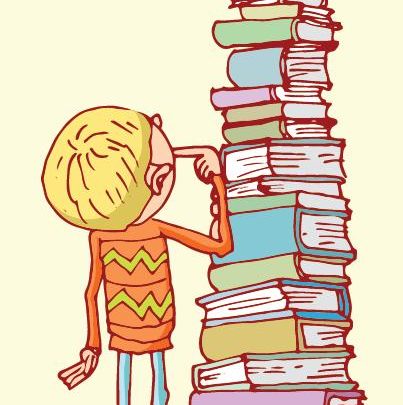“‘Poor Readers’ Don’t Need Easy Reads”

Can we really develop a love of reading in children by giving them harder books? Doug Lemov thinks so…

- by Doug Lemov

Let’s get a couple of things straight from the start: Doug Lemov doesn’t want to tell you, technique by technique, how to teach; nor does he think you are currently doing it all wrong.
Despite what some of his critics seem to believe, his popular but polarising handbook Teach Like a Champion was never meant to be used as a rigid blueprint for a single pedagogical ‘style’ – rather, it was a collection of simple strategies that Lemov knew to be effective, from extensive observation of successful classrooms, offered to educators so they could try them out for themselves. And now, alongside two of his colleagues at Uncommon Schools, he has taken the same approach to encouraging us to rethink a very specific area of the curriculum: reading.
“Our aim is always to highlight the benefits of constant reflection,” he explains. “And there are very good reasons to reflect, rigorously, on how we teach reading at the moment, and what we are sure is the right thing to do.” One of those reasons – undeniably compelling – is what Lemov describes as “the tyranny of correlation” linking socio-economic backgrounds with literacy attainment. When it comes to closing the gap, it seems we are not succeeding nearly as well with reading as we are with other subjects. “State assessments show that a student’s level of proficiency in reading is 1.5-2 times as strongly correlated with socio-economics as is his or her competency in mathematics,” Lemov points out. “What have we missed? And what is the cost of that correlation to a society that’s built on meritocracy? Reading is the key skill that opens doors to any kind of academic endeavour, and evidence shows that too many of our young people are applying for university not remotely prepared for the kinds of complex, deep reading they will be required to do there.”
Tough love
The book that Lemov has written with Erica Woolway and Colleen Driggs is called Reading Reconsidered and subtitled, A Practical Guide to Rigorous Literacy Instruction. “It does sound a little like a chapter heading in a Dickens novel,” he smiles when asked about this choice of language. “But we selected those words carefully. ‘Practical’ is important – we really did want to make this book useful for teachers. Theory and philosophy can be helpful, of course, but we were keen to talk about what actually happens in classrooms. And it’s deliberately piecemeal; we see it as a book of tools, so people can take aspects of it, give them a try, see if they work. Teachers already do a lot right, there’s no need for a ‘change everything from the ground up’ approach. You can take something from this book and test it out with your students tomorrow, without the angst of a ‘full reboot’.” And ‘rigorous’? “That has to be the goal for all kids,” Lemov insists. “Besides, rigour and joy are not mutually exclusive!”
There are four key precepts at the heart of Reading Reconsidered: read harder texts; ‘close read’ texts rigorously and intentionally; read more nonfiction, more effectively; write more effectively in direct response to texts. Can the first of these really be applied to teaching in primary schools, where children are taking their very earliest steps in the literacy journey? Absolutely, confirms Lemov, adding, “It’s become accepted, for example, that levelling reading books for children is the way to go. There’s a place for leveled texts, but students also need to be comfortable reading what’s challenging (and worthy of challenge). They need both – and I see the cost of neglecting that, all the time. High poverty kids arrive at school with low literacy levels, so they get given books that don’t challenge – or inspire – them. No one gives them a great book and says, ‘I’m going to help you enjoy this’. Schools identify them as ‘poor readers’, and give them easy reads by way of supporting them – but in doing so, they unintentially close doors of possibility for them.” According to Lemov, there is some evidence that many of the things we assume build a love of reading – such as allowing children to access easy, instantly appealing books; choose their own reading materials; and read stories about characters just like themselves – do not necessary achieve the desired outcome. “There is more to reading than following a snappy adventure,” he observes. “I didn’t become a reader, really, until a teacher gave me Hemingway’s The Old Man and the Sea when I was around 11 or 12; I enjoyed how demanding it was, yes, but also the depth of thought involved. There’s a mindset that says children should never be given books in which there are more than five words on a page they don’t understand – but I disagree; if we don’t teach children to unlock—and enjoy unlocking—a text that challenges them, who will?”
Shared stories
Reading with – and indeed, to – students is something that Lemov fears is becoming a dying art in schools. “Just hearing adults read books aloud helps children understand the purpose and potential of reading deeply, meditatively, with sustained concentration,” he says. “Reading silently; students reading aloud; teachers reading aloud to pupils – all three of these options have strengths and limitations, and in the book we advocate finding the right balance between them. It would be a gift to children, of course it would, if they were all exposed to reading earlier, read stories by their parents, and surrounded by books at home. But there will always be the disparate impact of parenting and/or setting for kids. We must assume we will always have children entering our schools who are behind in reading; and as important to me as the fact that some youngsters start Reception not knowing that you read a book from front to back and left to right, is that we still have kids in Years 5 and 6 who have never read a book in full; never felt that joy, the completion. Understanding narrative, enlarging the vocabulary, and unwinding complex syntax – all these can be achieved through adults reading books to children that they might struggle to decode alone.”
Try this tomorrow
According to Lemov, research shows a clear link between the breadth and depth of a child’s knowledge of vocabulary, and his or her reading ability. He suggests a different approach to introducing new words in the classroom. “At the moment, a teacher might say, ‘Who can tell me what ‘decrepit’ means?’” he explains. “Whereupon you get get a whole heap of wrong definitions – guesses – and eventually a ‘correct’ one, thought up on the spot by a 10-year-old. So how about, instead of that, you give them an excellent definition first, then spend time playing with the word, instead of guessing what it might mean? You might ask, for example, ‘Do you think you can be decrepit and wealthy?’ ‘Could a tyrant ever be decrepit? Why?’ ‘What might a decrepit person look like?’ This is how you learn a word’s shades and subtleties of meaning – because, as Isabel Beck points out in her excellent book Bringing Words to Life, if two words overlap 80% in meaning, like imitate and mimic, we tend to teach them as synonyms; but actually, it’s the differences between them that help us understand the nuances of text.”
Reading Reconsidered, by Doug Lemov, Erica Woolway and Colleen Driggs, is published by Wiley (£21.99)










